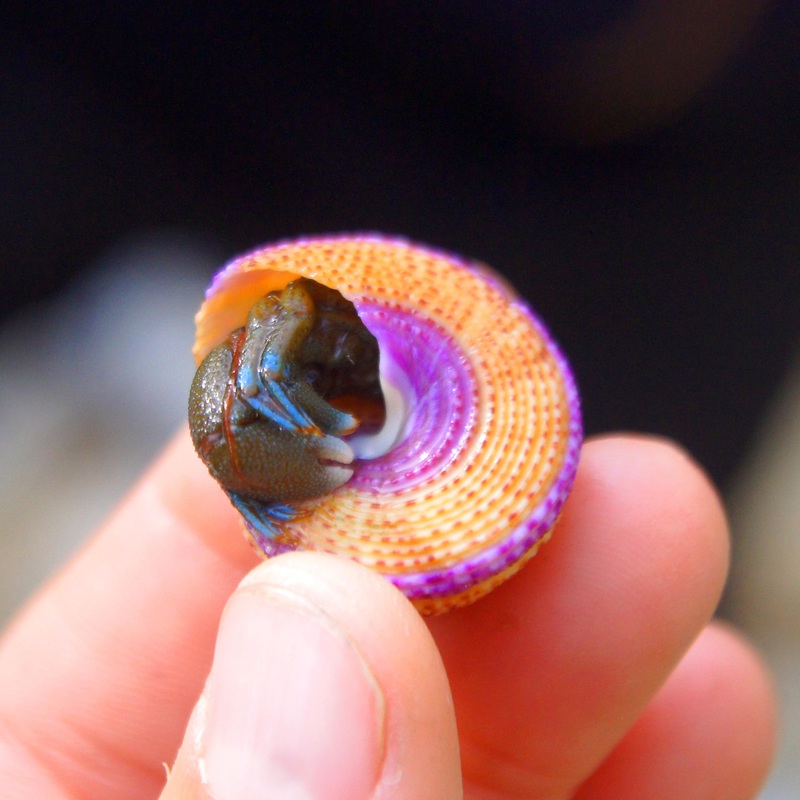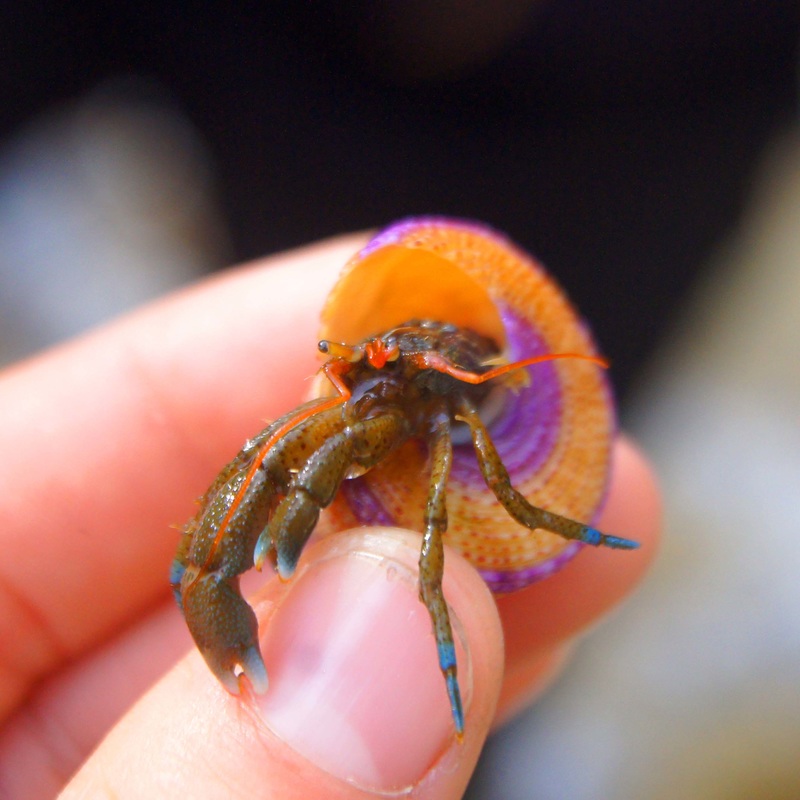Blueband hermit crab • Pagurus samuelis
While this species usually prefers black turban shells, this blueband hermit crab was found in a purple-ringed topsnail shell (Calliostoma annulatum). Photos by Katie Davidson.
Identification
The key identifying features of the blueband hermit crab are the bright blue bands encircling the tips of its walking legs, and its red unbanded antennae. Smaller crabs have white bands instead of blue. The body and claws are olive green. Tubercles give the claws a bumpy texture, and the body and claws are hairy with setae. Its carapace gets to 2 cm long, for a total length of around 4 cm. This species tends to prefer the shells of the black turban snail (Chlorostoma funebralis).
Habitat & Range
This hermit crab is found in the rocky intertidal and kelp forests on both exposed and protected shorelines on the outer coast. It can be abundant, and may be found in tidepools in the mid and low intertidal. Its range extends from central BC to northern Mexico.
Similar Species
The grainyhand hermit (Pagurus granosimanus) has an olive green body dotted with small whitish or blue granules, and orange antennae.
Intriguing Info
This hermit crab is particularly active in evening and at night. It scavenges on algae — especially giant kelp (Macrocystis pyrifera) — and on dead animal matter.
iNaturalist
https://www.inaturalist.org/taxa/49095-Pagurus-samuelis
The key identifying features of the blueband hermit crab are the bright blue bands encircling the tips of its walking legs, and its red unbanded antennae. Smaller crabs have white bands instead of blue. The body and claws are olive green. Tubercles give the claws a bumpy texture, and the body and claws are hairy with setae. Its carapace gets to 2 cm long, for a total length of around 4 cm. This species tends to prefer the shells of the black turban snail (Chlorostoma funebralis).
Habitat & Range
This hermit crab is found in the rocky intertidal and kelp forests on both exposed and protected shorelines on the outer coast. It can be abundant, and may be found in tidepools in the mid and low intertidal. Its range extends from central BC to northern Mexico.
Similar Species
The grainyhand hermit (Pagurus granosimanus) has an olive green body dotted with small whitish or blue granules, and orange antennae.
Intriguing Info
This hermit crab is particularly active in evening and at night. It scavenges on algae — especially giant kelp (Macrocystis pyrifera) — and on dead animal matter.
iNaturalist
https://www.inaturalist.org/taxa/49095-Pagurus-samuelis
References
Cowles, D. (2005). Pagurus samuelis (Stimpson, 1857). Invertebrates of the Salish Sea. Rosario Beach Marine Laboratory. Accessed 14/07/2017
Lamb, A. and Hanby, B. (2005). Marine Life of the Pacific Northwest [electronic version]. Madeira Park, BC: Harbour Publishing.
Pagurus samuelis - Blueband hermit crab. Sanctuary Integrated Monitoring Network (SIMoN). Accessed 14/07/2017.
Authors and editors of page
Kelly Fretwell (2017).
Cowles, D. (2005). Pagurus samuelis (Stimpson, 1857). Invertebrates of the Salish Sea. Rosario Beach Marine Laboratory. Accessed 14/07/2017
Lamb, A. and Hanby, B. (2005). Marine Life of the Pacific Northwest [electronic version]. Madeira Park, BC: Harbour Publishing.
Pagurus samuelis - Blueband hermit crab. Sanctuary Integrated Monitoring Network (SIMoN). Accessed 14/07/2017.
Authors and editors of page
Kelly Fretwell (2017).






